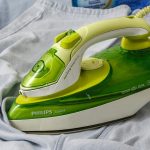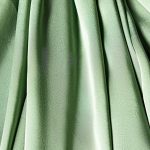I used to believe that linen absolutely had to be ironed to look presentable, but oh, how wrong I was!
The debate over whether linen truly requires the tedious task of ironing is one that many have pondered.
However, before you banish your iron to the back of the closet, let's explore the truth behind this age-old question.
Table of Contents
Key Takeaways
- Linen's low wrinkle resistance often requires ironing for a polished look.
- Proper folding and storage techniques can help minimize linen wrinkles.
- Linen benefits from gentle washing and air drying to maintain its luxurious texture.
- Removing linen from the dryer slightly damp can aid in wrinkle prevention.
Linen Fabric Characteristics
Linen fabric, known for its natural breathability and luxurious texture, is a popular choice for clothing and home textiles. Its unique properties make it a sought-after material.
When it comes to wrinkle prevention, linen can be a bit challenging. While some embrace the casual, relaxed look of wrinkled linen, others prefer a more polished appearance. To minimize wrinkles, it's advisable to remove linen from the dryer while it's slightly damp and then hang or lay it flat to dry completely.
Additionally, proper fabric care is essential to maintain the quality of linen items. It's recommended to wash linen in cool or lukewarm water with mild detergent and avoid using bleach to prevent weakening the fibers. Gently reshape and smooth out wrinkles by hand before air-drying or ironing on a low setting if a crisper look is desired.
Factors Influencing Linen Wrinkling
When it comes to linen wrinkling, the type of fabric plays a significant role in how prone it's to creasing.
Proper folding techniques can also make a big difference in keeping your linen garments looking smooth.
Additionally, the conditions in which you store your linen items can impact how wrinkled they become over time.
Fabric Type Impact
Considering the various types of fabrics used in clothing, the impact of fabric type on linen wrinkling is a significant factor to take into account. Different fabrics have varying levels of natural wrinkle resistance, affecting how prone they are to creasing. Here is a table illustrating how fabric type can impact linen wrinkling:
| Fabric Type | Wrinkle Resistance | Recommended Fabric Care |
|---|---|---|
| Linen | Low | Gentle machine wash, air dry |
| Cotton | Medium | Warm machine wash, tumble dry |
| Polyester Blend | High | Cold machine wash, low heat dry |
Understanding the fabric composition of your garments can guide you in choosing appropriate wrinkle prevention techniques and fabric care routines.
Folding Techniques Importance
Exploring effective folding techniques plays an important role in minimizing linen wrinkling and maintaining a crisp appearance in your clothing. When it comes to proper folding, consider the following key points for crease prevention:
- Fold Along Seams: Aligning the edges of your linen clothing along the seams helps maintain its shape and reduces the chances of deep creases.
- Use Tissue Paper: Placing tissue paper between folds can act as a barrier, preventing direct contact between fabrics and reducing wrinkles.
- Avoid Guaranteeing: Guaranteeing your folded linen items have enough space in storage to prevent excessive wrinkling caused by tight packing.
Storage Conditions Effect
Maintaining proper storage conditions is essential for minimizing linen wrinkling and preserving the quality of your clothing items. Proper care, including attention to humidity levels, can have a profound impact on the condition of your linen. Here are some key factors to contemplate:
| Factors to Contemplate | Description | Importance |
|---|---|---|
| Storage Location | Choose a dry, cool area | Minimizes wrinkles |
| Hanging vs. Folding | Hang delicate items | Prevents creases |
| Air Circulation | Allow airflow in the storage | Reduces moisture |
Benefits of Ironing Linen
Ironing linen not only enhances its appearance but also provides additional benefits that contribute to the overall care and longevity of the fabric. As someone who appreciates well-maintained linen, I find that ironing offers more than just smooth, wrinkle-free fabric.
Here are three key advantages of ironing linen:
- Essential Durability: Ironing helps maintain the fibers' alignment, reducing wear and tear over time.
- Improved Absorbency: By ironing linen, you can restore its natural moisture-wicking properties, making it more effective at keeping you cool and dry.
- Sharper Look: Ironed linen exudes a polished and professional appearance, perfect for both casual and formal settings.
Considering these benefits, ironing becomes not just a chore but an essential step in linen care and maintenance. While there are alternatives to ironing, such as steaming or using wrinkle-release sprays, the long-term advantages of traditional ironing make it a worthwhile practice for those seeking to master the art of linen care.
Alternatives to Ironing Linen
While ironing is a traditional method for maintaining linen, there are convenient alternatives that can achieve similar results with less effort. One effective alternative is the steaming method. Steaming involves using a garment steamer to release wrinkles by applying steam to the fabric. This method is gentle on linen and helps to relax the fibers, making it easier to smooth out wrinkles without the need for an iron.
Another alternative to ironing linen is using a wrinkle release spray. This spray works by misting the linen with a solution that helps to relax the fibers and release wrinkles. Simply spray the solution evenly over the wrinkled areas, gently smooth out the fabric, and allow it to dry. The wrinkles will begin to fade, leaving your linen looking fresh and neatly pressed.
Both the steaming method and wrinkle release spray offer quick and efficient ways to maintain your linen without the hassle of traditional ironing. These alternatives are perfect for those looking to save time while still achieving that crisp, polished look.
Tips for Wrinkle-Free Linen
When aiming for wrinkle-free linen, incorporating simple habits into your care routine can make a significant difference in the fabric's appearance and longevity. Here are some tips to help you keep your linen looking crisp and fresh:
- Steam Instead of Press: Using a garment steamer is a quick and effective way to remove wrinkles from linen without the need for ironing. Steaming is gentle on the fabric and can help relax the fibers to release wrinkles easily.
- Proper Washing Techniques: To maintain your linen's wrinkle-free appearance, it is crucial to follow washing dos and don'ts. Always wash linen in cool water on a gentle cycle to prevent excessive wrinkling. Avoid overloading the washing machine, as this can lead to more creases in the fabric.
- Hang Properly to Dry: After washing, hang your linen garments or items promptly to dry. Smooth out any wrinkles by hand before hanging to help the fabric dry with fewer creases. Avoid wringing out linen, as this can lead to stubborn wrinkles that are hard to remove.
Conclusion and Final Thoughts
In my experience, mastering these simple habits for caring for linen can elevate your fabric's appearance and guarantee it stays wrinkle-free for longer. When it comes to wrinkle prevention, proper washing, gentle drying, and careful storage are key. Additionally, choosing high-quality linen and investing in a steamer can greatly reduce the need for ironing.
| Wrinkle Prevention Tips | Ironing Necessity |
|---|---|
| Wash with mild detergent | Reduce by steaming |
| Air dry or tumble low | Choose quality linen |
| Fold neatly after drying | Invest in a steamer |
| Store in a cool, dry place | Use iron sparingly |
Frequently Asked Questions
How Do You Properly Store Linen to Prevent Wrinkles?
To properly store linen and prevent wrinkles, I recommend mastering folding techniques. Store linen in a cool, dry place, avoiding tight spaces. Hang linen items when possible or fold neatly to maintain their crispness and freshness.
Can Linen Be Ironed on a High Heat Setting?
Ironing linen on a high heat setting can be risky; it's best to check the care label first. To avoid scorching or damaging the fabric, use a lower heat setting or a pressing cloth. Proper linen care guarantees longevity.
Are There Any Home Remedies for Removing Wrinkles From Linen?
In linen care, I've found effective home remedies for wrinkle removal. A mix of water and vinegar sprayed lightly on linen, followed by gentle stretching, helps banish creases. It's a simple solution that keeps linens looking fresh.
How Often Should Linen Be Ironed to Maintain Its Appearance?
Ironing linen keeps it looking crisp. I find weekly ironing sufficient to maintain its appearance. Alternatively, steaming or hanging linen in a humid bathroom can help relax wrinkles. Consistent care prolongs linen's longevity.
Can Linen Be Ironed With Steam Instead of Using a Traditional Iron?
I find that steam alternatives work wonders for linen. They help prevent wrinkles effectively. I've seen great results using steam to freshen up my linen items. It's a convenient and efficient method.
- The Use of Nonwovens in Construction and Civil Engineering - July 11, 2025
- The Use of Nonwovens in Construction and Civil Engineering - July 11, 2025
- The Use of Nonwovens in Construction and Civil Engineering - July 11, 2025







